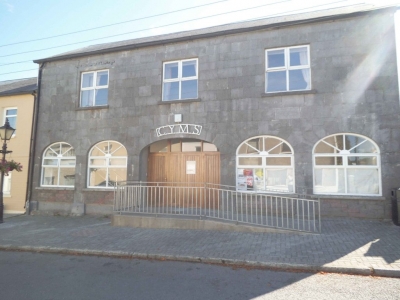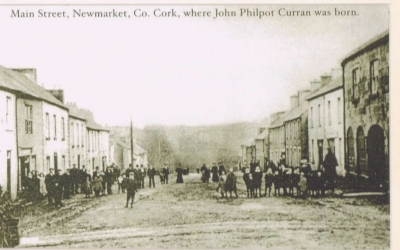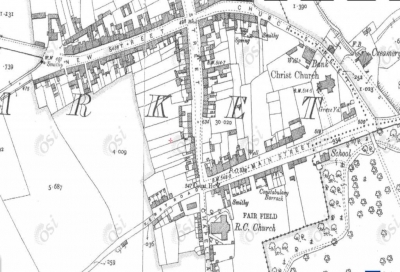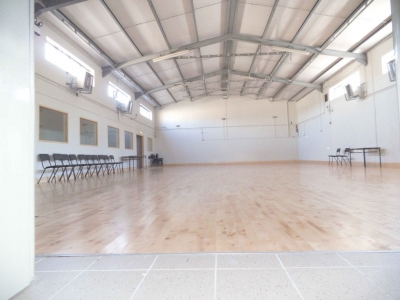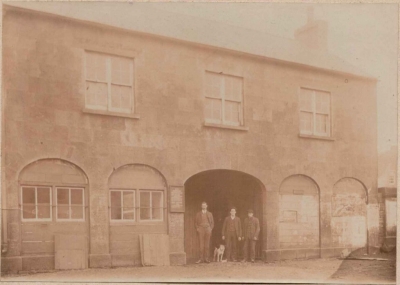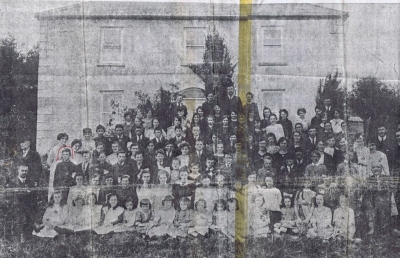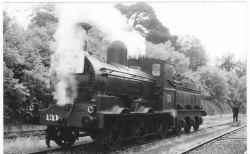by Patricia O’Keeffe, Killowen
The Architecture of the building:
The National Inventory of Architectural Heritage gives a full description of the building
“Attached two-storey former court and market house, built c. 1810, having three-bay first floor and five-bay arcaded ground floor, with slightly lower pitched metal-roofed extension to rear. Now in use as hall. Pitched artificial slate roof, having rendered chimneystacks with brick copings and cast-iron rainwater gutters. Cut dressed limestone façade, with painted rendered walls to other elevations. Square-headed openings to first floor with replacement timber windows, dressed limestone lintels and limestone sills. Segmental-arched openings to ground floor, with dressed limestone voussoirs, end arches having infill to lower parts and replacement timber windows above. Wider central arch has recessed replacement timber door.
APPRAISAL: This building follows a standard pattern for market and court buildings of having an open arcade to the ground floor. Though the original windows and doors have been replaced and the arcade no longer being open, this building provides a tangible link to Newmarket’s historical significance as a market town. The building is in an interesting position, on a corner site on a hill, though at a distance from the central cross streets of the town. The dressed stone façade has survived well and the change of use is typical and a good example of how such buildings can be reused. The maps identify an area to the south-west as a ‘fair field’. (National Inventory of Architectural Heritage, Irish Manuscripts Commission).
The courthouse has being built to what is thought to be a standard Pain design according to the North Cork Architectural Heritage. This group wrote that
“Market houses remained in integral part of town life until the middle of the century, they were usually built to a standard design with an arcade of three or four arches on the ground floor, coupled with a Pre- mentioned breakfront or floating pediment. In Newmarket (c.1810) Mitchelstown (1823), these buildings also served as courthouses. The classically inspired style of architecture lending them an air of gravity and authority”.
“Design for a court house and bride well to be built in the different Sessions Towns in the County of Cork” by James and George Richard Pain: (An Introduction to the Architectural Heritage of North Cork, NIAH 2009) this fact has also being mentioned in: (Photocopy in IAA. Irish Architectural Archive, Directory of Irish Architects 1720-1940)
It is also mentioned in manuscripts found in Waterford, 6 May 1824, Lismore Castle “drawings collection by James and George Richard Pain”. It was believed that these were master copies. But as such the building design has not being positively validated as being of a Pain Design
A Point of Interest. It was stated in (The Dictionary of Irish Architects lists the work and biographies of architects, builders, and craftsmen who were active in Ireland between 1720 and 1940. James and his younger brother GEORGE RICHARD PAIN).
“James Pain was already in Ireland by 31 July 1813, and his brother George Richard, who had probably joined him in Ireland in or soon after 1814”.
Does that mean it was James Pain alone that was the likely Architect of the building in Newmarket?
Also: According to Slater’s National Commercial Directory of Ireland, 1846 Newmarket, Co. Cork. “Petty Sessions are held every Friday, in a new Courthouse, A stone building beneath which the market is held” So the Question has to be asked, what did the old Courthouse look like? No descriptions or drawings were found of this old building during my research and another question? Would we consider a building still new after 36years?
According to (Niall McCullough, Courthouses-the mirror of society). Under King James The design pattern of Court/Market House Buildings were Classical because they used the patterns of Architecture of the times in which they were built and yet conformed to the realities of its purposed functions being court houses and Market houses.
“The extent to which the spread of legal uniformity is related to urban growth and town formation is striking, the courthouse as an ornament and support to new towns is a recurring theme in Ireland, and early examples were often combined with a market house function. They were located as public buildings within new town plans.”
(The Courthouse of Ireland, A gazetteer of Irish courthouses, Dunne, Mildred. Phillips, Brian. The Heritage Council)
Before the work was carried out in the 1970’s We know that there were two staircases of stone leading up from the lower level to the upper level at each end of the back gable wall. They lead up to a central doorway leading into the previous upper level. There was no other access to the upstairs of this building other than these Limestone steps. On the ground floor through the front door, you would have walked through a central corridor and to the left and right there was one room on either side of the corridor. Bathroom facilities were at the back of the garden in an outhouse. A local group took up fundraising in the early seventies and major regeneration work by local builder’s company was undertaken to give the building a new lease of life at that time.
THE BENCHMARK ON THE BUILDING:
Newmarket CYMS building has a Bench mark on the left hand side of the front door, our local Historian tells me this is one of a coterie of bench marks in Newmarket town. The benchmark of the Courthouse of Newmarket tells us that the building is 548 feet above sea level.(R. O’ Sullivan) The Benchmark was imprinted into the building sometime between 1837 and 1843 according to Ordinance survey Ireland, The map in my possession is dated 1942 and the bench mark is clearly marked on it.
“In surveying, a bench mark is specifically any permanent marker placed by a surveyor with a precisely known vertical elevation. These markers are then used as starting (control) points by subsequent surveyors and other users to establish the elevation of nearby points” (Irish Surveyors, Ordnance survey of Ireland Glossary of Terms: Benchmark)
1837 Irish datum point fixed on Poolbeg Lighthouse in Dublin bay for primary Levelling and contouring of Ireland. The Primary network was completed in 1843. The network of bench marks from the first levelling left a mark on the landscape in the form of the crow’s foot cut into walls buildings and bridges. (OSI Ordinance Survey Ireland, History. Interior Survey
Look closely at the picture below, can you pick out the marking on the CYMS building , there is a horizontal chiselled out line on top of Three slanted lines in a downwards fashion from the top horizontal line which is also known as the crow’s feet.
The Market in Newmarket:
Sir Richard Aldworth was a very astute man, to ensure the Plantation he received from King James 1st was a successful one, he acted immediately on the licence he also received for a Court House and Market and also to have specific days in the year for the Fairs to take place. He envisaged that his new Town of New Market as being the last Town where travellers travelling between Tralee to Cork or Tralee and Limerick would load up in provisions in Newmarket for the long road ahead of them as there would be no Towns between Newmarket and Tralee or Limerick whichever one they were travelling to. In doing this he set about creating a lucrative viable marketing outlet for the tenants and supplying the basic needs for the travellers.
The market and fair days were basically needed for the Tenants of the Barony of Duhallow, so that they could sell their produce in order to pay their rents to their Landlords. As Sir Richard Aldworth had the land rented out to Tenants, he recognised that the market was needed so that the farmers could sell their produce to raise the money for his rent. Farmers mainly sold meat and potatoes, eggs and vegetables. We know that butchers arrived from cork to buy and sell meat in the eighteenth century as John O Callaghan mentions in his article in the Seanchas Duthalla 1993. The markets nurtured community development as customers came far and near to buy and sell their produce. According to John O Callaghan in his article of Sean Chas Duthalla 1993, “Newmarket had a market almost from its first beginning’s”. We learn that people of Kanturk used the market in Newmarket as there was no rent for that market payable for its use to its owner, as appose to Kanturk where they had to pay rent to sell at the market and then in turn pay the landlord rent for the lands rented to them. It is noted by Mr Richard Purcell (agent) when he complained to Lord Percival of Kanturk that he was paying rent to hold a market in Kanturk but the his tenants and the towns business people went to the Newmarket’s Market as Sir Allworth did not charge any operational costs for the use of the market in Newmarket. (B.L. Add. Ms 46979 f3Richard Percival Senior to Lord Percival. 2 January 1728. Pat O Sullivan op. cit. p.104 gives an account of the market house built in 1728 and its replacement in 1747)
Sir Aldworth understood the dynamics between the Market, Court House and the fair days together for the town, and how they would relate to the tenants, travellers and those that lived on his estate in in the nearby towns/Villages as well as those from afar.
The market would increase the spin-off benefits on the surrounding community, by encouraging investment, thus improving social and economic benefits for his Plantation. These spin-off effects, in turn, will draw larger numbers of customers to the market,
In the following passages we can see how successful the market has being and how its success is mentioned over the years.
A Market were granted to Sir Aldworth by means of charter in the according to O’ Muimhneachain, Tadhg. (Paganism to Christianity in Duhallow). By the 1620’s Sir Richard Aldworth had being given permission to hold both markets and Fairs, he then had a market house built. These markets and Fairs were very successful. According to Sir John Percival of Kanturk’s Egmont estate in a letter to his brother in law who was considering moving to the Kanturk district at the time. “Your neighbour at Newmarket thrives with his Plantation”
Smith in 1751 wrote that “Newmarket is a considerable thoroughfare into Kerry”. Proving that Newmarket was indeed thriving. (Manuscripts of the old Corporation of Kinsale1944 No 15, Anlecta Hibernicia)
It becomes apparent that Sir Aldworth must have thought his market in Newmarket was in danger at one stage of being lost or decimated as Sir John Percival wanted to build a bridge over the river in order that Kanturk would have the advantage of being on the main thoroughfare to Kerry. Sir Aldworth declared that “The Bridge would ruin all his estate and all that was on it”. (B.L, Add. Ms. 46954A f59-60. Meade, Thomas, Cork to Sir Robert Southwell. 13 March 1677.)
“Its present name (That being Newmarket) is obviously derived from the establishment of a market at this place, which was granted to the family of Aldworth by Jas. I in 1615 on the forfeiture of the estate by the McAuliffe’s and confirmed in the reign of Chas”. (NEWMARKET, COUNTY CORK IN LEWIS TOPOGRAPHICAL DICTIONARY 1837: Samuel Lewis, Cork City and County Archives)
The market is on Thursday, and is chiefly for the sale of potatoes and turf; it is thought that if the day were changed to Friday, which would afford the Cork butchers an opportunity of attending both this market and that of Kanturk, it would contribute greatly to its improvement. Fairs are held on June 8th, Sept. 8th, Oct. 10, and Nov. 21st; the last is the principal for cattle, sheep, and pigs. A daily post between this place and Kanturk is supported by private subscription; a constabulary police force is stationed in the Town”. (NEWMARKET, COUNTY CORK IN LEWIS TOPOGRAPHICAL DICTIONARY 1837: Samuel Lewis).
“Ascension Thursday, 26 May 1910 saw large numbers of people descending on the town. Market day was busy”. (Violent Cork: Newmarket riot, May 1910. The hidden history of Cork city and county, 1890 – 1916) Here we can see that the market was thriving even though the author was writing about more troubled times in Newmarket rather than the market.
The market in Newmarket seems to have chequered history of being opened and operating or not operating at all for one reason or other, reason being in my research I have seen in some of the postal Directories that it is said of Newmarket.
Piggott’s and Co. Directory of 1824 wrote there is no market, and only speaks of fairs four times a year.
Samuel Lewis wrote 1837: the market is on Thursday, it is thought at that stage it should be changed to Friday to suit the butchers of Cork.
Slater’s National Commercial Directory of Ireland 1846 wrote “the market is held every Friday, fairs six times a year”
Guys Cork Almanac Directory 1907 wrote that fairs were once each month for cattle and fair days for pigs were held on the day previous to cattle fairs of each month. There was a calf, butter, egg and fowl market held on every Thursday.
Guy’s City and County Almanac and Directory for 1921
Fairs and Markets—14 Jan, 9 Feb, 6 Mar, 21 April,11 May, 8 June, 16 July, 15 Aug, 8 Sept, 10 Oct, 31 Nov, 19 Dec. Fairs falling on Saturday will be held on that day ; falling on Sunday, held on Monday. Pig market 1st Wednesday of each month. Horse fairs 3rd Thursday in Feb and 2nd Thursday in Oct. Calf market (opens 1st Thurs, April). Butter, egg and fowl market every Thursday
This is part of the 1842 map which I enlarged to show the Courthouse marked on the map and the benchmark is noted by the letters BM, 548 Ft signifies the height above sea level from this point.
Saving our Market Rights of Newmarket:
Market rights arose over the centuries and were usually granted by royal charter or statute to individuals or to locations. Markets subject to market rights were excluded from the scope of the Casual Trading Act 1980 but this was reversed in the current Casual Trading Act of 1995.
(Department of Enterprise, Trade and Employment July 2006.
www.corkcoco.ie )
According to an Phoblacht, “Local authorities across the state have been implementing a strategy of “use or lose it” on the exercising of rarely exercised rights to set up street markets and engage in casual trading” (4th May 2006.Edition, An Phoblacht)
To keep the rights of the market active in Newmarket, a purposeful market had to take place before May 1st 2006.according to legislation. That being under Section 7 (4) of the Casual Trading Act which deemed market rights unexercised by 1st May 2006 to be extinguished.
(Department of Enterprise, Trade and Employment July 2006.
www.corkcoco.ie )
So with that in mind our local business woman Olive Forde with the help of her daughter Brid set up her market in Newmarket on the 28th of April 2006 to establish a legal right to a market/fair in the town. Records will show that active trade was witnessed by Dermot Jones, Lower Road and Gerald Murphy, Newmarket. (Olive Forde, Newmarket, Cork)
Olive with her husband John Forde are very distinguished food producers, Under the Certification Body of Irish Organic Farmers’ and Growers’ Association (IOFGA). They are Producers of Pork, Bacon, Beef, and Lamb. They sell their produce at many Farmers Markets, they also are a Demonstration Farm and hold Day Visits to the farm. They are have a very successful business through their farm gate sales. Their Pork is a Bridgestone Award winner according to The Organic Centre, the Organic Guide for Ireland.
(http://www.organicguide.ie)
History of Newmarket Court house:
Newmarket Court House has a varied and interesting past. It was one of the basic prerequisites in the area for the town to develop. Sir Richard Aldworth was member of the crown forces of England, he fought in the wars at the time, In 1621 Sir Richard was in the kings favour, when he received a grant of land to the value of 200 English pounds rent a year, the claims to these lands was forfeited by the previous owners The McAuliffe’s of Clanawley. Sir Richard was knighted in 1612.
In the following passages we see how that the Court House is mentioned:
“Petty sessions are held on alternate Thursdays; and a Court for the recovery of debts not exceeding 40s. Every third Friday, for the manor of Newmarket, which extends over 32,000 statute acres in the parish of Clonfert” (NEWMARKET, COUNTY CORK IN LEWIS TOPOGRAPHICAL DICTIONARY 1837: Samuel Lewis)
According to the Guy’s Directory Newmarket Petty Sessions are heard every third Wednesday of the month.
The Courthouse is mentioned in Records written by W. M. Brady D.D, He was writing of John Philpot Curran’s birthplace being to the west of the present courthouse in 1863(Clerical and Parochial Records of Cork, Cloyne and Ross)
It seems over the years that the day of the week of the Petty Sessions have changed as we see by (Guys Postal Directory. 1907 Almanac) “Petty Sessions were on every second Friday”.
Petty Sessions Court heard cases such as stealing, malicious damage to property belonging to others, not paying for a day’s labour, family squabbles, neighbours quarrels, fighting, drunkard’s, livestock trespass, damaging crops and fences and Poaching. Etc.,
They could impose fines, a couple weeks in jail at a time, the maximum a person could be sent to jail for was 1 year with or without hard labour depending on the Justice of the peace and the crime. Petty Sessions could bind a person to the peace. Until the 1920’s petty sessions were the lowest courts in the country. When a case was too serious in nature it would be referred onto the Quarterly Sessions or the Assizes Court in Kanturk.
Petty Sessions were held in the smaller towns in the Counties, with a number of Justices of the Peace allocated to cover all the courts in that district, Newmarket shared the Justices of Peace with Tralee, Kanturk, Killarney, and Cork. That we know of through writings of William Taylor, an agent that accompanied the judges from Cork to Kerry and on one occasion Limerick is mentioned. (Sean Chas Duthalla 1993)
Richard Aldworth had the assize Judges and gentry staying in his own home for a number of reasons, one being to improve the Aldworth’s social life and the other important point being to keep the businesses and markets of Newmarket thriving.
We also learn that Sir Richard Allworth wanted Newmarket to stay on the main route into Kerry so he provided good accommodation for Travellers on the road.
According to Berkeley Taylor to Lord Percival 29th January 1719
“The Allworth’s have systematically set about making Newmarket a more logical place in which to stay”. There was a new route being proposed by Lord Percival through Kanturk to Kerry.
The Petty Sessions were recognised in law in 1827 even though they were in progress for centuries previous to this. People in Ireland at this time were concerned about decisions made by untrained Justices of the Peace. So under the Petty Sessions (Ireland) Act 1851 Justices of the Peace were slowly replaced by trained Professional paid Judges. The Petty Sessions were replaced by the District Courts in Ireland in 1924(Petty Sessions Order Books 1842-1913: Institutions and Organisations: Find my Past)
In 1923 The Judiciary Committee’s recommendations for the new Court System were adopted in The Courts of Justice Act, 1924. It created a District Court to replace the court of petty sessions and the Justice of the Peace. This structure was replicated in the 1937 Constitution. (History of the Law 1691 – present: Heritage An tSeirbhis Chuirteanna/ Courts Service IRELAND. New Courts System)
Through my research I have come across some notices that drew my attention to Notices brought to the Bench at the Newmarket Petty Sessions.
Notice 1 from the Kanturk board of guardians:
29 Nov 1877: Letter from the Privy Council Veterinary Department regarding
Appointments under the Pleura Pneumonia Act; Letter from Newmarket Petty
Sessions regarding their appointment of an inspector under the Explosives
Act 1875. 20 Dec 1877 (BG/98/A Kanturk Board of Guardian Minute Books)
Notice No. 2:
“The Following Petty Sessions Courts were adjourned out of a mark of respect to the dead King James: – Ballineen, Newmarket, and Ballydehob, Co. Cork. Dr Neville Justice of the Peace Ballineen stated that in King Edward, Ireland had lost a great friend that ever sat on a throne”. (Archive. Irishnewsarchive.com)
Notice 3.
The magistrates at Newmarket, Co. Cork Petty Sessions passed a vote of sympathy with Richard Aldworth on the death of his brother Major Aldworth, a highly successful fellow magistrate. (Archive.irishnewsarchive.com)
According to Francis Guys Almanac. Quarter Sessions Notice under the Munster heading, PGE. 109 1884.the Officers of the Petty Session of the Newmarket area were as follows:
NEWMARKET
“Deputy Lieutenants. Aldworth Richard Oliver, Newmarket
JUSTICES OF THE PEACE:
Aldworth Col. Richard William, Newmarket
Aldworth Colonel Robert, Cheltenham
Aldworth Richard Oliver, D.L, Newmarket
Verling B. W, Springfield lodge, Newmarket”
Guy’s City and County Almanac and Directory for 1921
“PETTY SESSIONS COURT. Newmarket
Petty Sessions held each alternate
Friday. Quarter Session of Mallow
Clerk Petty Session—Newmarket: R. H. Fetherston
COMMISSIONER AFFIDAVITS.
R. H. Fetherston, CP S
Civil Bill Officers County and City Cork.
NEWMARKET AREA: Jeremiah Quinlan and David Quinlan
So I now ask the question, was the courthouse completely destroyed or was it only part damaged and reconstruction undertaken in either case, as in statements above in 1919 said it was destroyed. But according to Guy’s City and County Directory of 1921 it was in use again as a courthouse.
J.J. O’Riordain, 1985, stated that the destruction of Newmarket Courthouse in April of 1920 was one of many events linked back to the H- Company of Kiskeam and the Flying column, known also as the North Cork Flying Column. (O’Riordain, 1985)
The Destruction of the Court House Newmarket:
According to John Jones, Killowen, Newmarket,
Eye Witness Statement, Lieutenant same Company, 1920-.
Military Archives.
This is a passage in his statement as he told the statement.
“During 1919 it was strongly rumoured that a military
Garrison was due to occupy Newmarket. So it was decided to
Destroy the Courthouse, which was a very likely place for
Occupation. The Courthouse was the upstairs portion of a
Two-storey building and the lower part of the premises was a
Very large egg store. Under charge of Seán Moylan, and with
Bill Moylan and D. McAuliffe, our Company, a lot of whom were
Armed, assembled at the premises one night. We removed a
Huge quantity of egg cases, timber and other stores and success-
Fully destroyed the whole building, including all the Court
Records.
During this operation we had a party of armed men, under
Paddy McCarthy, covering off the R.I.C. Barracks adjacent to
The Courthouse. They made no attempt whatever to interfere
With us, for they realised it would have been futile to do so.
While the burning was in progress the local District Inspector,
R.I.C. (named Dignan) entered the R.I.C. Barracks: He did not stir out again that night.”
Through my own research I have found that it was John O’ Brien of House 20 on Main Street, Newmarket had the Egg store on the lower level of the court house, According to the 1911 Census he was an Egg and Poultry Merchant. It is my understanding that this man would have being Councillor John O Brien’s father.
Other Groups and societies that have used the hall as a base for their meetings in the past:
The building came back into the Free State of Ireland sometime in the 1920’s and most of the Aldworth Properties were sold off. The Catholic Church took over the Court house/Market house and rear yard between the years 1927 and 1931, this is learnt from a letter dated in 1928 belonging to the Aldworths. (Registry of Deeds, Dublin)
The Catholic young men’s Society had access to the hall in the 1940’s,50’s and 1960’s where under Spiritual Director’s Guidance they passed the time discussing local and national politics, and the goings on in the community in general such as matches and sports. Some of the Spiritual Directors were Fr Donal McCarthy, Fr. Sheehan, Fr. Roche and Fr. Glennon and Matt Jones was Secretary for many a year, Raymond o Sullivan was Secretary for Three years of the Society. Many a good debate was had in this society. This was a well ran and successful society by all means according to locals in our community.
There was a beautiful billiard’s table which was used by all ages at the time. Tournaments were set up against Charleville and the competitors would travel back and forth for matches. Paddy Murray, Joe Gorman and Danny Riordan, Matt Jones, Dan Halliden and Danny Donoghue the reliving Officer to name a few were all men in Particular that were good at the game. I have being told that Danny Donoghue was an excellent Reliving Officer.
There are many fond memories of games played there I am told by locals. On speaking to locals they tell me that they gave most evenings in the hall. Young boys waited for the chance to be allowed access to the CYMS, they were not allowed until they were 15-16 yrs. of age. It was every young boy’s ambition to play on the Billiards table, you had to pass an exam to be allowed near it. First you had to be able to make a bridge with your fingers for the stick to rest on, if you tore the cloth of the table it would have being considered the ultimate sin according to locals. There were high seats around by the walls where they waited patiently for a chance to get on the Billiards table. The boys had to be of a certain height to play also.
There was also Table Tennis and cards to play, many a game of 45 and poker were had for small change only. There were two tables for the card games.
The Readers Digest Monthly was available to read free of charge in the CYMS and certainly it was the one magazine that was well read by all.
The opening times of the CYMS Hall then was after mass on the Sundays to 6-7 pm and on Week days 6pm to 11.30pm approx. weekdays. (C.Reilly, D. Jones, M. Halloran and R. O Sullivan)
“I was hon. sec. but I’d say 3 or 4 years from the early to mid-’60′s.We had several ways of financing the club – an annual raffle, hops (mid- week dances that finished at midnight), etc. and we had 2 meeting rooms which we let out at 5 shillings a night during the Summer and 7 shillings and 6 pence during the Winter. The extra 2 and 6 went to the caretaker for setting the fire etc. As far as I can remember there was a small membership fee and you had to be 16 yrs. old to join.” (R. O Sullivan)
The Community centre was also a School twice: The first time was in 1945 to 1954. Locals went to the National School in Newmarket, Boherbue and the village of Meelin and onto private school in the CYMS Hall for Secondary School for Three Years up to the Inter Certificate as it was called then what we know as the Junior Cert today. The reason it was said to be a private School was that families paid 8 Irish Pounds a year per pupil to attend in the year of 1949 I have being informed. If a student was to progress in the education system in Newmarket then, you would graduate into the follow on secondary school at the top the hill just above the St. Mary’s Church where Vincent O Conner lives today, the class there was in the front left room of the front entrance door. At that time in the upstairs quarters, there would have been an unused look out sentry post on the left back gable end of the school house where the roof is curved. Paddy O Keeffe also ran this school and students would complete their Leaving Certificate here.
The Principal of the Secondary School was Paddy O Keeffe, Vice Principal: Eilis O Keeffe, Miss Dwayne taught Commerce and Geography
The fourth Post in the school was somewhat thought to be temporary as teachers came and went in short periods of time, for example there was a Miss Hobbs from Cork City also taught in the School, Miss Renee also taught in the school at a different time in that same post and a Mrs Julia Breen married in Boherbue also taught in this post a different time.
The Community Hall served as a Secondary School between 1945 and 1954 then the school was moved to the local Protestant Trinity Christ Church, Newmarket.
There were 28 boys in the Secondary School in Newmarket in 1945 according to the (Table showing the numbers of pupils in a recognised secondary schools: 1945 Department of Education) I could not access how many girls attended the school at that time. The children went to school in the CYMS Hall 5½ days a week from 9am to
1pm. It was also told to me that Mrs Julia Breen would load up her car in Boherbue with children and bring them on to the CYMS for the school. When you entered the building from the front door, you would have walked through a central corridor and to the left and right there was one room on either side of the corridor.
On the ground floor level of the School, there was a back door out on to what was then a beautiful garden belonging to Jerry Philpot, the hall was much smaller then and this garden would have covered the area where the stage once was. The aroma from this garden was always wafted through the air. (D. Jones, R. O Sullivan V. O Conner)
The CYMS Hall was transformed in to a School again in the early 1980’s, (Department of Education) Our local boys National School was being extended and the pupils and Teachers transferred up into the Hall for a period of time. (C McAuliffe)
The ICA was a tenacious group within the community in the 1940’s 50’s and 1960’s organising outings, arts and crafts and competitions for the lady members. Ardent members such as Nelly Daly, Rosacon and Mary O Keeffe, Kerry Road were great to organise events for the ladies. (B. o Keeffe)
The hall was Quiet for a lot of the late 60’s and early 70’s but a Parish Council was formed from there laid new beginnings, A Committee was formed in the early 1970’s and it was decided to refurbish the hall. A major fundraising campaign was taken on and enough funds were gathered to refurbish the hall. The hall was renovated in the 1970’s by a local builder in which an extension was put on.
On the opening night an accomplished accordion player by the name of Dermot O Brien played to a large crowd. It was a memorable night for all. (Corkman)
In the early 1970’s, there were two meeting rooms, one cost 5 shillings to rent and the other cost 7and six, sometimes the care taker would get an extra half a crown.
Conradh Na Gaeilge known also as the Gaelic League had meetings regularly in the Hall. In the late 50’s it was active and its aim was to promote the Irish speaking language through dance, song, music and recitations. They fund raised once a year on St. Patrick’s Day. This group were organizing an Eireach/garden Fete in the 1961 approx. year and they had a pipe band booked for the social event. The band cancelled on the group and so it was decided in Newmarket Conradh Na Gaelge to form their own Pipe Band here in Newmarket. The Band came together and starting practicing in the CYMS Hall, this was their base for many a year until they fundraised to erect their own Hall which is still to this day alive with the music of the Pipe Band. Paddy Murray was their Treasurer for years. People like May Linen, Julia Cronin, Bill Flynn of Barley Hill, Jim Cronin, Liam Cudihy from Kilkenny, Dermot Jones were all members of this group. (D. Jones)
Muintire Na Tire was also a very energetic group that used the hall at the time. Muintir Na Tíre is a national organisation promoting community development in Ireland. In Newmarket when Muintir Na Tíre was a very spirited organisation it promoted and supported the concept of active community participation and focused on the idea of community development in Newmarket foremost and Ireland. Newmarket’s Muintire Na Tire was involved in a lot of fundraising for various events in the area. (D. Verling)
Marca Na Feirme had a strong group in Newmarket in late 1970’s, this group met once a month. It was mainly a young Farmers club which promoted active involvement community events. (P.O Keeffe)
The Legion of Mary are also another group that used the hall on a regular basis during this time. This is a religious catholic prayer group which met weekly. This also as a successful group in Newmarket. (J. Moynihan)
The ‘Thursday Club’ is very active group in the town. They have held many meetings in the community centre over the years.
There were many Caretakers of the Community Hall down through the years, looking after maintenance and the general upkeep of the hall. Some of those men were (not in order): Jerry Philpot, Denny Collins, Paul Brosnan, Joe Rahailly, John Lucey, Jimmy Cross, John Buckley, M. Clifford, Teddy Mahony and Jerry Moynihan to mention a few. There were many more around Newmarket that have looked after the Hall lovingly. (C. Reilly, M. O Halloran and J. Moynihan)
Long Standing Treasurer: Paddy Murray of Newmarket was the treasurer of the CYMS Hall for a good 25 years. He was very dedicated to the CYMS Hall, He produced his book in which he recorded all the monies in and out and he always provided receipts for each transaction without ever being asked to. He was a very upfront man. (D. Jones)
Newmarket Drama Group:
Newmarket Drama Group are a very successful group within the community and have many successful plays to their credit staged in the Community Centre of Newmarket to name a few: ‘Lend me a Tenor’ by Ken Ludwig, and ‘Many Young Men of Twenty’ by John B. Keane and ‘Moonshine’ by Jim Nolan. (Various Corkman Articles)
The local Drama Group is an amateur drama group which strives to draw from the huge talent base within the town and county and is open to all, inviting people to get involved, They very active group within the community of Newmarket.
Past And To the Future:
In the past The CYMS Hall has being fundamental to the wellbeing and to the growth of Newmarket as a trading town. It has served as an central active part in Newmarket’s history down through the years from being a Marketplace and Courthouse, to a Barracks, and Egg store to a School and a meeting place for young men to its existing roll which is to support Newmarket’s community projects holistically well into the future. In today’s terms the CYMS Hall still has a big role to play in the locality by facilitating local groups such as Drama, Fitness, exercise, dance, music. A Meeting place, a place of learning to a place of leisure, to a safe haven for our youth in the community. The future of the CYMS Hall looks secure because of its central role in local groups and its interests in facilitating these groups to function and aid them to reach their own goals. The Present Committee welcome all groups Large and Small to use the Community’s Centre.
2013/14 Committee Members are as follows:
Chairman: C. McAuliffe, Sec, H. O Keeffe, Treas.: S. Guerin, Pro: E. Higgins
Charles Gilman, Fr. D. Herlihy, T. O Sullivan, J. O Keeffe, M. Murphy, P. O Keeffe.
Caretaker: Sonny Cronin.
Bibliography:
- Clerical and Parochial Records of Cork, Cloyne and Ross: W. Maziere Brady D.D. Chaplain to the Lord Lieutenant and Vicar of Clonfert and Cloyne: Vol 11. DUBLIN. Printed for the Author, Alexander Thom, 87 & 88 Abbey Street, 1863
- Corkman advertisements. Cork City Library, Cork City Library Archives.
- Department of Education. School Inspections Newmarket. Introduction – School Context and Background Whole School Evaluation: REPORT: Scoil Na mBuachaillí: Date of inspection: 9 March 2006. www.departmentofeducation.ie:
- Dictionary of Irish Architects lists the work and biographies of architects, builders, and craftsmen who were active in Ireland between 1720 and 1940. James and his younger brother GEORGE RICHARD PAIN. www.dia.ie:
- Destruction of the Court House Newmarket. John Jones, Killowen, Newmarket: Eye Witness Statement, Lieutenant same Company, 1920-.Military Archives. BUREAU OF MILITARY HISTORY, 1913-21. DOCUMENT NO. W.S. 759: Original Document. www.bureauofmilitaryhistory.ie:
- Dunne. Mildred. Phillips. Brian. The COURTHOUSES OF IRELAND. A gazetteer pf Irish Courthouses. 1st Published 1999.The Heritage Council. Pge. X. Niall McCullough, Courthouses-the mirror of society
- Freemans Journal: Monday Sept. 18th 1882: Sat 13th October 1900: Freemans Journal: Cork County Newspapers Archives, Cork City Library, Cork.
- Find your ancestors in Irish Petty Sessions Court Registers 1828-1912. Petty Sessions Order Books 1842-1913: Institutions and Organisations: www. Find my Past Website.
- Guy’s City and County Cork Almanac and Directory for 1907. Cork Past & Present. Cork City Council. Libraries. Cork’s history, culture, places, people, and events
- Guy’s City and County Almanac and Directory for 1921. Street and Trade DIRECTORIES. Cork Past & Present.
- History of the Law 1691 – present: Heritage An tSeirbhis Chuirteanna/ Courts Service IRELAND. New Courts System) www.courts.ie/Courts.ie:
- Irish Independent, 1910: Sat June 4th 1910. Saturday, August 20th 1910 Saturday, Cork County Newspapers Archives, Cork City Library, Cork: Archive. Irishnewsarchive.com. Irish Independent, Cork City Library
- Irish Surveyors, Ordnance survey of Ireland. Glossary of Terms. Benchmarks. www.scsi.ie
- OSI Ordinance Survey Ireland, History. Interior Survey. www.osi.ie
- Interviews held with Local people of Newmarket at various locations in Newmarket. July/August 2014: M. Reilly, D. Jones, M. Halloran, V. O’ Conner, C. McAuliffe, B. O’ Keeffe, P. O’ Keeffe. . DR. D. Verling. J. Moynihan and a very valuable source of both historical and present information: Raymond O Sullivan.
- NIAH 2009.National Inventory of Architectural Heritage. An Introduction to the Architectural Heritage of NORTH CORK, Department of the Environment, Heritage & Local Government.
- National Inventory of Architectural Heritage, Irish Manuscripts Commission Heritage. www.corkcoco.ie/Cork%20County%20Council/…/Heritage/Quick%20
- NEWMARKET, COUNTY CORK IN LEWIS TOPOGRAPHICAL DICTIONARY 1837: Samuel Lewis, Cork City and County Archives.
- NEWMARKET, COUNTY CORK IN LEWIS TOPOGRAPHICAL DICTIONARY 1837: Samuel Lewis.
- O’ Muimhneachain, Tadhg. 1993. Seanchas Duthalla. Pge.23. From Paganism to Christianity in Duhallow
- O Callaghan. John. 1993 SEANCHAS DUTHALLA. Pge 45 no.40. Travelling in Duhallow before 1760. B.L. Add. Ms 46979 f3Richard Percival Senior to Lord Percival. 2 January 1728. Pat O Sullivan op. cit. p.104 gives an account of the market house built in 1728 and its replacement in 1747.
- O Callaghan. John. 1993 SEANCHAS DUTHALLA. Pge 44 no.10. Travelling in Duhallow before 1760. B.L, Add. Ms. 46954A f59-60. Meade, Thomas, Cork to Sir Robert Southwell. 13 March 1677.
- O Callaghan. John. 1993. Travelling in Duhallow before 1760. Seanchas Duthalla. Page. 27-45.
- O Callaghan. John. Travelling in Duhallow before 1760. SEANCHAS Duthalla 1993. Manuscripts of the old Corporation of Kinsale. November1944. No 15, Anlecta Hibernicia. Pge.53. A new road from North Kerry to Cork City.
- O’ Riordain, J. J. 1985. Kiskeam versus The Empire. Chap. 4. Specializing in Generals.1st Edition printed by The Kerryman.
- Photocopy in IAA. Irish Architectural Archive, Directory of Irish Architects 1720-1940. PAIN, GEORGE RICHARD. www.dia.ie
- Pigot & Co’s Provincial Directory of Ireland 1824. Munster.pge.303-304
- Table showing the numbers of pupils in a recognised secondary schools: 1945 Department of Education
- The Courthouse of Ireland, A gazetteer of Irish courthouses, Dunne, Mildred. Phillips, Brian. The Heritage Council
- Slater’s National Commercial Directory of Ireland, 1846 under Newmarket Heading. Samuel Lewis Directory1837:
- Violent Cork: Newmarket riot, May 1910. The hidden history of Cork city and county, 1890 – 1916 Turbulent Cork. The hidden history of Cork city and county, 1890 – 1916. wordpress.com
- 1911 Census. O Brien. Newmarket: Census of Ireland 1901/1911: National Archiveswww.census.nationalarchives.ie:
- 20 Dec 1877 (BG/98/A Kanturk Board of Guardian Minute Books, the Irish Independent, Cork City Library Archives.

